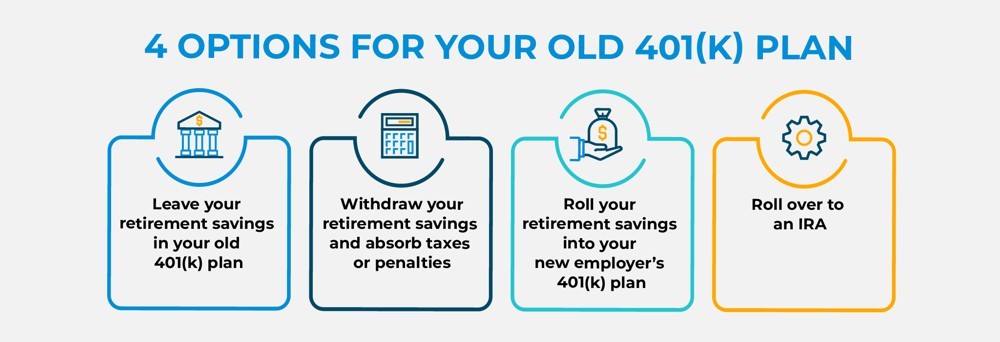As you embark on a new job opportunity, it’s essential not to overlook one crucial aspect of your financial well-being: your 401(k) plan. Many individuals fail to address their old retirement accounts when transitioning to a new job, either due to a lack of reminders or uncertainty about the rollover process. However, understanding how to transfer your 401(k) to a new job is essential for securing your financial future.
In this comprehensive guide, we will delve into the intricacies of 401(k) rollovers, the benefits of prioritizing this financial move, and the various options available when handling your retirement savings during a job transition.
Quick Navigation:
Understanding the Importance of a 401(k) Rollover

The Perils of Neglecting Your Old 401(k)
Neglecting to roll over your 401(k) when changing jobs can have significant financial consequences. Many companies make the rollover process complex and user-unfriendly, leading individuals to forget or procrastinate on the necessary steps. However, the benefits of initiating a rollover far outweigh the inconveniences.
One primary risk of neglecting your old 401(k) lies in the hidden fees associated with the account. These fees, such as record-keeping, maintenance, and fund fees, can accumulate over time, eroding your retirement savings. While your employer might cover some of these fees while you are employed, they may become your responsibility once you leave the company.
The Power of Compound Interest
To fully grasp the importance of a 401(k) rollover, one must understand the concept of compound interest. When you invest in a 401(k) account, your contributions have the potential to grow over time through compounding. Essentially, you earn returns not only on your initial contributions but also on the accumulated interest from previous periods.
By leaving your 401(k) with your previous employer, you risk missing out on the compounding effect of your investments, potentially hindering the growth of your retirement funds. In contrast, rolling over your 401(k) to a new job can ensure that your contributions continue to benefit from the power of compound interest.
3 Reasons to Prioritize a 401(k) Rollover
1. Hidden Fees May Impact Your Savings
One of the primary reasons to prioritize a 401(k) rollover is to avoid the impact of hidden fees on your retirement savings. These fees can vary widely depending on your previous employer’s plan and the investment options offered. They not only affect your immediate financial situation but can also significantly reduce the long-term growth of your retirement funds.
To assess the impact of these fees, it’s crucial to understand the expense ratio of your 401(k) plan. The expense ratio represents the percentage of your investment used to cover administrative and management costs. A high expense ratio can eat into your returns, while a low one can boost the growth of your retirement savings.
2. Seize Better Investment Opportunities
Another compelling reason to consider a 401(k) rollover is the opportunity to access better investment options. Different retirement plans offer various investment vehicles, such as mutual funds, index funds, and target-date funds. Some plans may even allow for individual stock investments.
By transferring your funds to a new employer’s plan or an individual retirement account (IRA), you gain the chance to diversify your portfolio and tailor it to align with your risk tolerance and financial goals. Furthermore, certain 401(k) plans may limit the investment choices available, whereas an IRA offers greater flexibility in investment selection.
3. Simplify Your Retirement Savings
Juggling multiple retirement accounts can become overwhelming, making it challenging to track your progress towards your financial objectives. By consolidating your old 401(k) into your new employer’s plan or an IRA, you streamline your retirement savings, making it easier to manage and monitor.
Consolidation not only simplifies the tracking of your investments but also allows you to assess your overall asset allocation and make adjustments as needed. This strategic approach to managing your retirement savings can lead to a more efficient and well-balanced portfolio.
Key Considerations for 401(k) Rollovers
1. Explore Your New Employer’s Plan
Before initiating a 401(k) rollover, take the time to explore your new employer’s retirement plan. Familiarize yourself with the investment options, fees, and any employer matching contributions. Comparing this information to your old 401(k) plan will help you make an informed decision about the rollover.
Some employers offer generous matching contributions, which can significantly boost your retirement savings. In such cases, it may be beneficial to prioritize a rollover to the new employer’s plan to take advantage of these employer contributions.
2. Evaluate Investment Fees
When comparing your old and new 401(k) plans, pay close attention to the investment fees associated with each. High fees can substantially impact your returns over time. If your previous employer’s plan charges exorbitant fees or lacks investment options that align with your financial objectives, rolling over to an IRA might be a more suitable option.
3. Assess Tax Implications
It’s essential to understand the tax implications of a 401(k) rollover. When done correctly, rollovers to new employer plans or IRAs can be tax-free. However, if not handled properly, they may result in taxable distributions and potential penalties.
Consulting with a tax professional or financial advisor can help you navigate the tax implications of a 401(k) rollover and ensure you make the most tax-efficient decision.
Exploring Your Options: Where to Roll Over Your 401(k)
1. Rollover to Your New Employer’s Plan
If your new employer offers a 401(k) plan, you may choose to roll over your old 401(k) directly into the new plan. This option provides the benefits of consolidation and simplification, as your retirement savings will be held in one account.
However, before opting for this approach, carefully evaluate the investment options and fees of the new plan to ensure they align with your financial goals. If the new plan offers better investment choices and competitive fees, a rollover to your new employer’s plan may be the right choice.
2. Rollover to an Individual Retirement Account (IRA)
Rolling over your 401(k) to an IRA offers greater control over your investments and potentially lower fees. An IRA allows you to choose from a broader range of investment options, including stocks, bonds, mutual funds, and more.
Moreover, an IRA is not tied to your employer, providing you with greater flexibility and portability. This means that even if you change jobs again in the future, your retirement savings will remain in your control, making an IRA a versatile option for long-term financial planning.
3. Consider a Roth Conversion
If you have a traditional 401(k) and are interested in a Roth IRA, you may explore the option of a Roth conversion. This process involves converting your traditional 401(k) funds into a Roth IRA, which allows for tax-free withdrawals during retirement.
It’s essential to note that a Roth conversion will trigger a tax liability in the year of the conversion. Therefore, before proceeding, assess your current tax situation and consult with a tax professional to determine if this strategy aligns with your overall financial plan.
Taking Action: The Steps to Perform a 401(k) Rollover
1. Contact Your Former Employer
To initiate a 401(k) rollover, begin by contacting your former employer’s benefits department or retirement plan administrator. They will provide you with the necessary paperwork and guidance to begin the rollover process.
2. Choose Your Rollover Destination
Decide whether you want to roll over your 401(k) into your new employer’s plan or an IRA. Consider the factors discussed earlier, such as investment options, fees, and employer matching contributions, to make an informed choice.
3. Complete the Rollover Paperwork
Once you’ve made your decision, complete the required paperwork for the rollover. Be sure to follow the instructions carefully and include any additional documents that may be necessary.
4. Transfer the Funds
Upon completing the paperwork, your former employer will initiate the transfer of your 401(k) funds to the designated account. The process may take some time, so be patient during the transition.
5. Monitor Your Investments
After the rollover is complete, regularly monitor your investments to ensure they align with your financial goals and risk tolerance. Periodic reviews with a financial advisor can help you stay on track and make any necessary adjustments.
Potential Roadblocks: Overcoming Challenges in a 401(k) Rollover
1. Incomplete Rollovers
In some cases, individuals may inadvertently receive a distribution check for their 401(k) funds instead of performing a direct rollover. If this occurs, it’s essential to act promptly to avoid tax consequences.
You have 60 days from the date you receive the distribution check to complete the rollover. If you fail to do so within the specified period, the distribution will be treated as taxable income, and you may be subject to a 10% early withdrawal penalty if you are below 59 ½ years old.
2. Ineligibility for a Rollover
While most 401(k) plans allow for rollovers, some plans may have restrictions or limitations. For example, certain employer-sponsored plans may only permit rollovers for employees who have reached a specific age or service requirement.
In such cases, an IRA might be the only viable option for a rollover. Consulting with your former employer’s benefits department or a financial advisor can help you understand the rollover rules and eligibility criteria.
Conclusion
Transferring your 401(k) to a new job is a crucial step in securing your financial future. Understanding the importance of a rollover, the benefits it offers, and the various options available is essential for making informed decisions about your retirement savings.
By prioritizing a 401(k) rollover, you can avoid hidden fees that erode your retirement savings, seize better investment opportunities, and simplify your money management efforts. As you explore your rollover options, consider the investment options, fees, and employer contributions offered by your new employer’s plan, as well as the flexibility and control provided by an IRA.
Remember that taking action and carefully following the rollover process are vital to ensure a smooth transition of your funds. Be proactive in making informed choices about your retirement savings and seek guidance from financial professionals when needed.
A 401(k) rollover is a significant financial decision that can have a lasting impact on your financial security during retirement. By understanding the options available and the steps involved, you can navigate the rollover process with confidence, empowering you to take control of your financial future and achieve your retirement goals.

![25 Great Jobs that Work from Home or Anywhere [Remote work]](https://jobsmarketupdate.com/wp-content/uploads/2021/10/Great-Jobs-that-Work-from-Home.jpg)




